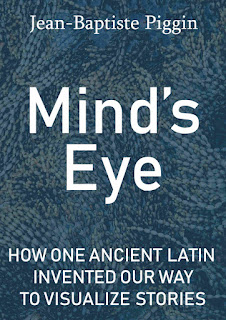When were family-tree diagrams invented? My new book, Mind's Eye: How One Ancient Latin Invented Our Way to Visualize Stories, uncovers the progenitor of today's graphic timelines and trees in an ancient three-meter-wide chart of history.
Hidden in plain sight, the Great Stemma -- a Roman masterpiece -- has never been honored at book length before.
The Great Stemma was not only a vast visual abstraction of the march of time from Creation as far as the birth of Jesus Christ, but also marked a swerve in civilization towards exploiting our visual perception as an extra tool for thinking.
I argue that diagrams and visual displays exploit the computing power of human vision to short-cut our reasoning tasks. Cognitive science is only now able to grasp what a major shift in human culture this was. My research places that creative leap in the ancient world.
I foreshadowed Mind's Eye two years ago (when the book's working title was "Expositor" and I was still following up some loose ends in the inquiry). Since then, I have added some great cover art (the theme comes from Neptune's Necklace, a wondrous seaweed from the South Pacific) and converted the manuscript to e-book format. A print version may follow.
Here's the link which leads to stores where you can buy Mind's Eye at a low introductory price: https://books2read.com/PigginMindsEye (to which I add a modest plea: buy from one of the non-Kindle stores, where the price to you is the same, but I get a bigger royalty!)
Mind's Eye can be read rapidly, by skimming the 117 illustrations and checking out the QR links. Or it can be savored as an 88,000-word narrative in which I narrate how I brought this neglected graphic to light.
Hidden in plain sight, the Great Stemma -- a Roman masterpiece -- has never been honored at book length before.
The Great Stemma was not only a vast visual abstraction of the march of time from Creation as far as the birth of Jesus Christ, but also marked a swerve in civilization towards exploiting our visual perception as an extra tool for thinking.
I argue that diagrams and visual displays exploit the computing power of human vision to short-cut our reasoning tasks. Cognitive science is only now able to grasp what a major shift in human culture this was. My research places that creative leap in the ancient world.
I foreshadowed Mind's Eye two years ago (when the book's working title was "Expositor" and I was still following up some loose ends in the inquiry). Since then, I have added some great cover art (the theme comes from Neptune's Necklace, a wondrous seaweed from the South Pacific) and converted the manuscript to e-book format. A print version may follow.
Here's the link which leads to stores where you can buy Mind's Eye at a low introductory price: https://books2read.com/PigginMindsEye (to which I add a modest plea: buy from one of the non-Kindle stores, where the price to you is the same, but I get a bigger royalty!)
Mind's Eye can be read rapidly, by skimming the 117 illustrations and checking out the QR links. Or it can be savored as an 88,000-word narrative in which I narrate how I brought this neglected graphic to light.




No comments :
Post a Comment